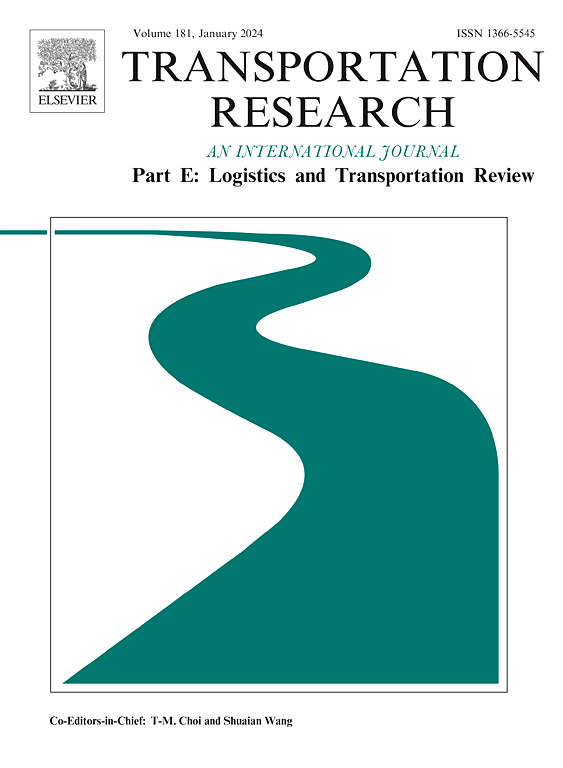决策时机、信息推断和信息共享:双向信息不对称的稳健供应链博弈
IF 8.3
1区 工程技术
Q1 ECONOMICS
Transportation Research Part E-Logistics and Transportation Review
Pub Date : 2024-10-16
DOI:10.1016/j.tre.2024.103807
引用次数: 0
摘要
本文研究了在双向信息不对称条件下由零售商和制造商组成的双螺旋供应链,在这种情况下,双方分别拥有私人需求信息和成本信息。针对信息不对称带来的不确定性,本文采用稳健优化方法来模拟博弈中企业的风险规避行为。我们加入了一种信息传递机制,即被支配企业通过信息推断获得支配企业决策中包含的部分私人信息。我们探讨了决策时机和推断之间的相互作用,然后研究了完全和部分信息共享策略,揭示了信息流在供应链运营中的关键作用。结果表明了需求和成本信息差距对企业运营的影响,其中信息差距分别定义为需求和成本的最坏情况约束与实际值之间的差值。此外,当两个信息差距较大或需求较小时,企业可能不愿意共享信息。因此,我们提出了一些诱导信息共享的补贴策略,以实现双赢。此外,在不考虑推理的情况下,先行动而不共享信息在大多数情况下都是纯策略的纳什均衡。我们说明了如何通过补贴和推理来改变均衡,然后提供了特定情况下的混合策略纳什均衡。结果还表明,在博弈中先行并不总是有利的。这取决于追随者的信息差距、推理水平和信息共享策略。最后,在扩展部分,我们讨论了信息推断成本和渠道侵占的影响,并基于信号博弈验证了我们的结果。本文章由计算机程序翻译,如有差异,请以英文原文为准。
Decision timing, information inference, and information sharing: A robust supply chain game with two-way information asymmetry
This paper examines a two-echelon supply chain consisting of a retailer and a manufacturer under two-way information asymmetry, in which the two actors have private demand and cost information, respectively. In response to the uncertainty caused by information asymmetry, a robust optimization approach is used to model the risk-averse behavior of the enterprises in the game. We incorporate an information transmission mechanism by which the dominated enterprise would obtain partial private information contained in the decision of the dominant enterprise through information inference. We explore the interaction between decision timing and inference, then investigate full and partial information sharing strategies to reveal the critical roles of information flow in supply chain operations. The results illustrate the impact of demand and cost information gaps on enterprise operations, where the information gap is defined as the difference between the worst-case bound and the actual value of the demand and the cost, respectively. In addition, enterprises may not prefer sharing information when the difference between the two information gaps is large or the demand is small. Hence we propose some subsidy strategies for inducing information sharing which can achieve win-win situations. Moreover, moving first and not sharing information is a pure-strategy Nash equilibrium in most situations when not considering inference. We illustrate how the equilibrium can be changed through subsidy and inference, then provide mixed-strategy Nash equilibrium for specific situations. The results also indicate moving first is not always advantageous in the game. This depends on the follower’s information gap, inference level, and information sharing strategy. Finally, in an extension, we discuss information inference costs and the impact of channel encroachment, and we validate our results based on a signaling game.
求助全文
通过发布文献求助,成功后即可免费获取论文全文。
去求助
来源期刊
CiteScore
16.20
自引率
16.00%
发文量
285
审稿时长
62 days
期刊介绍:
Transportation Research Part E: Logistics and Transportation Review is a reputable journal that publishes high-quality articles covering a wide range of topics in the field of logistics and transportation research. The journal welcomes submissions on various subjects, including transport economics, transport infrastructure and investment appraisal, evaluation of public policies related to transportation, empirical and analytical studies of logistics management practices and performance, logistics and operations models, and logistics and supply chain management.
Part E aims to provide informative and well-researched articles that contribute to the understanding and advancement of the field. The content of the journal is complementary to other prestigious journals in transportation research, such as Transportation Research Part A: Policy and Practice, Part B: Methodological, Part C: Emerging Technologies, Part D: Transport and Environment, and Part F: Traffic Psychology and Behaviour. Together, these journals form a comprehensive and cohesive reference for current research in transportation science.

 求助内容:
求助内容: 应助结果提醒方式:
应助结果提醒方式:


